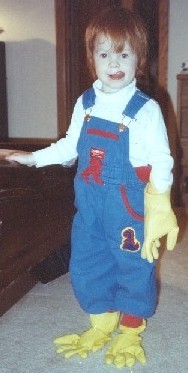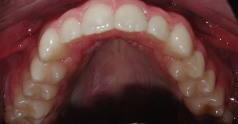Current Topics
Daily homecare routines vary from patient to patient. Therefore, at your cleaning appointment, we will go over what is the best home routine for you. However, in general, we recommend patients brush twice a day for five minutes (each time) and floss once a day. Often, we find that patients have not been instructed to floss correctly, so we are more than happy to personally go over proper flossing technique with you. When flossing, the floss is gently snapped between the contact area and then is wrapped around the tooth (making a 'C' shape around the tooth). The floss is moved up and down scrapping the surface of the tooth. This is done 4 to 5 times. The floss should slide under the gums between the teeth. This is repeated on the adjacent tooth. This should be performed around every tooth and even on the back side of the last teeth.
We strongly believe that fluoride is necessary for heathy teeth. If your drinking water comes from the tap, (in the Metro Denver area), then it is fluoridated. Bottled water will have fluoride listed on the bottle if it is present. Fluoride has many benefits: it helps with sensitivity, reduces the incidence of decay, and it remineralizes the tooth. We apply fluoride to the teeth after a cleaning. Patients with a high rate of decay, we will recommend fluoride for daily home use.
We have taught many of our patients how to toothpick. Flossing is helpful, but for some patients the floss does not go as deep into the pockets as necessary, which is why we have them toothpicking. When toothpicking you should trace along where the gum and tooth meet. Between the teeth you should make a little circle. This helps break up the bacteria that lie in the sulcus around the teeth. This should be done once or twice a day depending on the severity of your case. We would be more than happy to show you personally how to toothpick. Toothpicking is a great method to improve the periodontal status of a patient's mouth. We have seen fantastic results with toothpicking.
Diet plays a large role in oral health. High sugar consumption can lead to tooth decay, which is why I recommend monitoring your sugar intake. For example, when drinking tea or coffee, do not add sugar. If you drink soda, limit yourself to one serving a day and drink it with a meal. Sipping on soda all day can be detrimental to your teeth. Abstaining from soda is more prudent. Limit the amount of candy you are eating. Again, this is something that has a lot of sugar and should be monitored. If a patient has a high decay rate then we will most likely suggest fluoride and changing habits or lifestyles. Eat balanced and healthy meals, breakfast is the most important, this will greatly reduce the chances of decay. You will be healthier.
Fluoride Varnish.
We feel that today's' patients have become complacent and even think that they are invincible to tooth decay. The truth is that they could be at more risk than ever before. Our society is consuming more sugar than they have in the past. The incidences of tooth decay, obesity, and diabetes are increasing at alarming rates in our population. Most of my patients are at moderate to high risk of tooth decay and I strongly recommend professionally applied topical fluoride. Topical fluoride can be applied as gels, foams, rinses, or the newer varnishes. Fluoride varnish is a safe higher dose of fluoride and it is painted onto the teeth with a brush. The fluoride varnish sticks to the teeth and little is swallowed so very few patients experience nausea. The patient should not brush or use mouth rinse that has alcohol in it for 4-6 hours. The patient can drink water and eat immediately after the application. Professionally applied fluoride varnish is one step in the prevention of decay. Also, it protects expensive existing dental work from recurrent decay. In addition, fluoride varnish helps with tooth sensitivity.

"Optimal Dentistry" in my mind is "no dentistry" or "preventive dentistry". I would like to illustrate this with my son's mouth. He has been my patient since birth and this is what you would expect for a dentist's son.



The previous images show healthy teeth and gums. None of the teeth have fillings and are decay free! His dental treatment was the following:
1. Routine dental visits from when he was born.
2. Sealants on both baby teeth and adult teeth.
3. Routine fluoride treatments.
4. Good daily home hygiene.
5. Good nutrition habits. Very little soda pop or candy.
6. 3rd molars removed before orthodontic treatment.
7. Orthodontic treatment, 2 years.
8. Equilibration.


Digital Radiographs are great. Less radiation. No waiting. Can be e-mailed or burned on a CD. No chemicals to hurt the environment. We have been using this technology for several years and would not go back to X-ray film.
Cough drop warning!
We have had several patients that have been decay free for years and then suddenly they have numerous teeth with decay. When we interviewed these patients we found that they had recently started a habit of sucking on cough drops. These patients usually are older and started sucking on cough drops because their mouth or throat was dry. Many of these patients were taking medications that have a side effect of decreasing their salivary flow. Most of these patients did not realize that cough drops are mostly sugar and prolonged daily use would cause decay just like candy. This innocuous inexpensive home remedy has resulted in disastrous tooth decay problems. Many of these patients are retired and on a fixed income and expensive dental bills are an unexpected financial hardship. So, please avoid using cough drops. There are other solutions for dry mouth other than cough drops. Please discuss this with me at your appointment.
New Requirement for Dental Offices Disclose Fees for Top 15 Procedures
ADMIN NOVEMBER 28, 2017 FEATURED NEWS
In the age of high deductible health plans and plans that cover fewer and fewer services, there has been a growing chorus of consumer voices pushing for greater price transparency from healthcare providers. Healthcare price transparency bills have come before the Colorado state legislature for the last several years, and in 2017, the Colorado state legislature passed Senate Bill (SB) 65, which requires all healthcare providers and facilities to publish a list of cash pay prices (fees). Dentists are specifically included in the scope of the new law, and it appears to apply to dental hygienists as well. With nearly 60 of 100 state legislators of all political leanings as co-sponsors alone, the CDA advocated for a number of reforms to the bill to reduce the burden for dental offices as much as possible. All dental offices must comply with new fee disclosure requirements by Jan. 1, 2018.
Under the new law, a document listing at least the fees for the 15 most common healthcare services provided by the office is required to be made available electronically or on the provider’s website and needs to be updated at least annually. If you practice within a small group practice of six or fewer identically licensed providers (includes both dentists and dental hygienists), you may post the information in the patient waiting room for your practice, as opposed to providing it electronically or on a website. As long as fees do not vary substantially between providers in a dental practice who practice under a single tax ID number, fees may be posted in aggregate for the practice as a whole.
What You Need to Do
- Identify the top 15 codes that your office has billed for the past 12 months for all patients using practice management software or a review of your office’s billings
- Calculate the cash-pay, non-discounted fees for these 15 codes using one of the methodologies suggested below (or a substantially equivalent approach)
- Compile a single document that lists the 15 codes, a plain-English code description and the associated cash-pay fee as well as required disclosure language detailed below
- Post this document in a conspicuous place on your website, if you have one, or otherwise make it available electronically (if your office has 6 or fewer licensed providers of the same license type, you may satisfy posting requirements by making a printed copy of the document available in your patient waiting room)
- Update this fee list at least annually
Methodology for Determining Cash-Pay Prices
Cash-pay fee include all services that are exclusively self-pay as well as services that a third party carrier (insurer or benefit plan) does not pay. Cash-pay fees include the amounts your office charges patients covered by dental plans for services not covered under their specific plan (non-covered services).
If your office already maintains and uses a schedule of usual and customary billing rates (UCR) for self-pay (or all) patients and you track the top 15 CDT codes (or frequently billed CPT/diagnosis codes for certain specialists) provided by the office in the last 12 months, compliance with new requirements should be fairly simple. You may simply make a list of your office’s 15 codes, a plain-English code description and the UCR fee, as this should reflect the ‘price’ you most frequently charge for a self-pay patient for the service excluding any discounts. If you offer a self-pay promotion or discount, exclude these fee reductions from the listed fees, as the law is intended to disclose fees before any discounts are applied.
For other offices, start by reviewing your office’s gross billings of all patients for the last 12 months (include at minimum data fields for each CDT code billed and the billed amount). Sort your data to determine the top 15 codes billed. Once you have identified the top 15 CDT codes billed, reduce your list of codes billed to include cash pay patients only by excluding any services that were reimbursed by a third-party (e.g., private dental plans, public payers like Medicaid or Medicare) or adjusted due to a discount plan. Be sure to keep records on billings for any non-covered services (where an insured patient has no benefit/insurance payment for a particular service) in your list. If you offer a cash-pay promotion or discount, adjust the remaining billed amounts to the pre-discounted level. This exercise should leave you with a list of non-discounted cash-pay services provided by your office. Sort your list by CDT code and determine the fee for each of your previously-identified top 15 procedures using any of the following methods:
- Identify the fee charged most frequently for the CDT code during the prior 12 months (mode)
- Choose the highest fee from the lowest half of all fees during the prior 12 months (essentially the median fee)
- List a range that includes the middle 50% of all fees during the prior 12 months (25-75th percentile range)*
(*Note: Using a range of fees is the recommended methodology if you are in a dental practice where fees among providers vary substantially enough that posting a single fee might be considered misleading to a patient.)
Your office is not required to disclose the methodology used to calculate the disclosed fee. This bill does not create any obligation to report fees to any government agency for review and no agency is given authority to approve, disapprove or limit your fees. Insurers are prohibited from using the information required in SB 65 to their financial advantage in contract negotiations, a protection that CDA negotiated on behalf of its members.
If your dental office regularly provides less than 15 services, you are only need to disclose fees for the actual number of services that you provide.
Disclosure Language
As part of your fee list, disclosure language is required indicating that the fee published is not a guarantee of cost to an individual. Use the following statement or a statement containing substantially similar information on your fee list:
“The health care price listed for any given health care service is an estimate. Actual charges for the health care service are dependent on the circumstances, including any complications or exceptional treatment, at the time the service is rendered.
If you are covered by health insurance or a dental plan, you are strongly encouraged to consult with your insurer or plan to determine accurate information about your financial responsibility for a particular health care service provided by a health care provider at this office. If you are not covered by health insurance or a dental plan, you are strongly encouraged to contact our billing office at [insert telephone number] to discuss payment options prior to receiving a health care service from a health care provider at this office since posted health care prices may not reflect the actual amount of your financial responsibility.”
There is no regulatory or enforcement agency responsible for the interpretation of SB 65, complicating the implementation of this new law. As the law takes effect and more guidance or case law becomes available, the CDA will publish additional information for its members.

